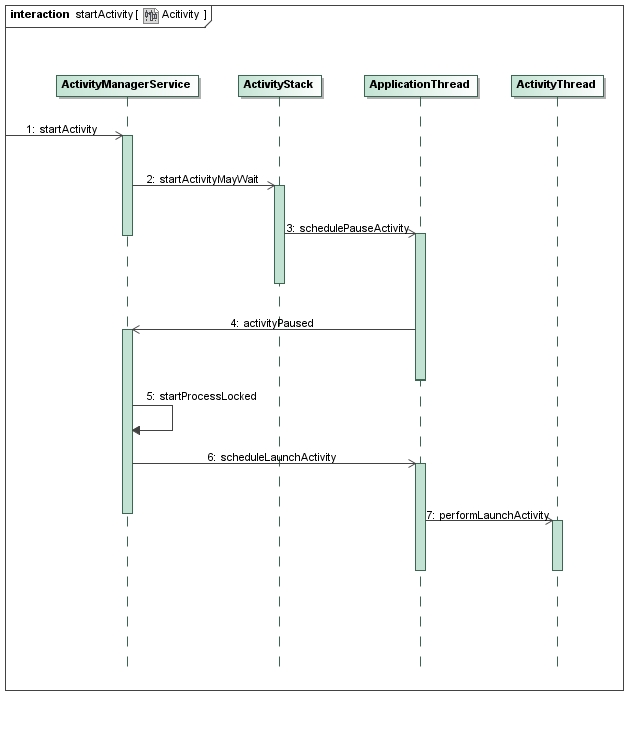你真的懂Handler的消息机制吗?
作为一名Android开发人员,Handler的使用非常的普遍,但是还是有很多人经常不合理的使用,导致了一些内存泄漏等问题,这篇文章主要详细的从源码角度上再次梳理下Handler的运行机制
- 什么是Handler
- Handler的源码分析
- Handler应该注意
- 可以替代Handler的方案
Handler 是什么
Google 文档的定义是:
A Handler allows you to send and process Message and Runnable objects associated with a thread’s MessageQueue. Each Handler instance is associated with a single thread and that thread’s message queue. When you create a new Handler, it is bound to the thread / message queue of the thread that is creating it – from that point on, it will deliver messages and runnables to that message queue and execute them as they come out of the message queue.
意思大概是:Handler 发送和处理MessgeQueue关联的Message和Runnable 对象,每个Handler实例关联一个线程,当创建一个新的Handler的时候,它绑定了一个线程和消息队列,并且执行当前线程队列的消息。
Handler的源码分析
Handler 涉及到 Message、MessageQueue,Looper,Handler 这个四个类。
Message:消息实体
MessageQuque:消息队列,存储消息的单元
Looper:生成消息队列,绑定Handler,以循环的形式,来让消息跑起来
Handler:处理和发送消息
Handler的分析,Handler的创建,开始是一定要创建Looper,主线程的Looper,在ActivityThread 创建的,而ActivityThread涉及到了AMS启动Activity的过程,Activity启动过程(可以参考罗升阳https://blog.csdn.net/luoshengyang/article/details/6685853),如图所示,

在ActivityThread 里面的main函数发现
public static void main(String[] args) {
....
//生成UI线程的Looper
Looper.prepareMainLooper();
ActivityThread thread = new ActivityThread();
thread.attach(false);
if (sMainThreadHandler == null) {
//得到Activity UI 线程的默认Hander
sMainThreadHandler = thread.getHandler();
}
if (false) {
Looper.myLooper().setMessageLogging(new
LogPrinter(Log.DEBUG, "ActivityThread"));
}
// End of event ActivityThreadMain.
Trace.traceEnd(Trace.TRACE_TAG_ACTIVITY_MANAGER);
//启动消息循环
Looper.loop();
throw new RuntimeException("Main thread loop unexpectedly exited");
}
继续跟进Looper类的prepareMainLooper():
//对象通常被当作静态域存储
static final ThreadLocal<Looper> sThreadLocal = new ThreadLocal<Looper>();
public static void prepareMainLooper() {
//初始化Looper
prepare(false);
synchronized (Looper.class) {
if (sMainLooper != null) {
throw new IllegalStateException("The main Looper has already been prepared.");
}
sMainLooper = myLooper();
}
}
public static void prepare() {
prepare(true);
}
private static void prepare(boolean quitAllowed) {
if (sThreadLocal.get() != null) {
throw new RuntimeException("Only one Looper may be created per thread");
}
//将looper存储在ThreadLocal里面
sThreadLocal.set(new Looper(quitAllowed));
}
当看到new Lopper的时候,已经明白了,就是这时候先检查ThreadLocal里面是否有Looper,如果有,就抛出异常,因为每个Thread 里面只能有一个Looper, 当创建Looper对象后,这时候,消息队列也被创建出来了。
private Looper(boolean quitAllowed) {
mQueue = new MessageQueue(quitAllowed);
mThread = Thread.currentThread();
}
ThreadLocal:用于创建和管理线程的本地存储,可以为使用相同的变量的每个不同的线程创建不同的存储,意思就是,如果你有N个线程要使用Looper所表示的对象,那么线程本地存储就会生成N个用于Looper的不同存储块。ThreadLocal 对象通常被当作静态域存储.
因此,我们从上面源码可以得出,在创建一个实例化Handler之前,必须先准备好为当前线程创建一个Looper,UI线程调用Looper的prepareMainLooper再调用prepare方法,其他线程直接调用prepare静态方法 生成Looper并用sThreadLocal.set进行存储。获取Looper的方法很简单,通过sThreadLocal.get() 获取当先线程的Looper.
现在Looper有了,Handler有了,通过Handler.obtainMessage(),调用Message.obtain(this),可以看出Message是以链表形式存储。
public static Message obtain(Handler h) {
Message m = obtain();
//在这里设置了下Message的target,message对象指向了所在的Handler的
m.target = h;
return m;
}
public static Message obtain() {
synchronized (sPoolSync) {
if (sPool != null) {
Message m = sPool;
sPool = m.next;
m.next = null;
m.flags = 0; // clear in-use flag
sPoolSize--;
return m;
}
}
return new Message();
}
调用Handler的sendMessage方法,依次调用sendMessage->sendMessageDelayed->sendMessageAtTime,查看Handler的sendMessageAtTime
public boolean sendMessageAtTime(Message msg, long uptimeMillis) {
MessageQueue queue = mQueue;
if (queue == null) {
RuntimeException e = new RuntimeException(
this + " sendMessageAtTime() called with no mQueue");
Log.w("Looper", e.getMessage(), e);
return false;
}
//将message添加到消息队列里
return enqueueMessage(queue, msg, uptimeMillis);
}
private boolean enqueueMessage(MessageQueue queue, Message msg, long uptimeMillis) {
msg.target = this;
if (mAsynchronous) {
msg.setAsynchronous(true);
}
return queue.enqueueMessage(msg, uptimeMillis);
}
接着查看下MessageQueue里面的enqueueMessage方法
boolean enqueueMessage(Message msg, long when) {
if (msg.target == null) {
throw new IllegalArgumentException("Message must have a target.");
}
if (msg.isInUse()) {
throw new IllegalStateException(msg + " This message is already in use.");
}
synchronized (this) {
if (mQuitting) {
IllegalStateException e = new IllegalStateException(
msg.target + " sending message to a Handler on a dead thread");
Log.w(TAG, e.getMessage(), e);
msg.recycle();
return false;
}
msg.markInUse();
msg.when = when;
//mMessage是链表的头
Message p = mMessages;
boolean needWake;
if (p == null || when == 0 || when < p.when) {
// New head, wake up the event queue if blocked.
msg.next = p;
mMessages = msg;
needWake = mBlocked;
} else {
// Inserted within the middle of the queue. Usually we don't have to wake
// up the event queue unless there is a barrier at the head of the queue
// and the message is the earliest asynchronous message in the queue.
needWake = mBlocked && p.target == null && msg.isAsynchronous();
Message prev;
for (;;) {
//构建一个循环链表
prev = p;
p = p.next;
if (p == null || when < p.when) {
break;
}
if (needWake && p.isAsynchronous()) {
needWake = false;
}
}
//将新的message加入到循环列表中
msg.next = p; // invariant: p == prev.next
prev.next = msg;
}
// We can assume mPtr != 0 because mQuitting is false.
if (needWake) {
nativeWake(mPtr);
}
}
return true;
}
接下来Looper调用loop方法讲消息循环起来。
public static void loop() {
final Looper me = myLooper();
if (me == null) {
throw new RuntimeException("No Looper; Looper.prepare() wasn't called on this thread.");
}
final MessageQueue queue = me.mQueue;
// Make sure the identity of this thread is that of the local process,
// and keep track of what that identity token actually is.
Binder.clearCallingIdentity();
final long ident = Binder.clearCallingIdentity();
for (;;) {
Message msg = queue.next(); // might block
//没有消息的情况
if (msg == null) {
// No message indicates that the message queue is quitting.
return;
}
// This must be in a local variable, in case a UI event sets the logger
final Printer logging = me.mLogging;
if (logging != null) {
logging.println(">>>>> Dispatching to " + msg.target + " " +
msg.callback + ": " + msg.what);
}
final long slowDispatchThresholdMs = me.mSlowDispatchThresholdMs;
final long traceTag = me.mTraceTag;
if (traceTag != 0 && Trace.isTagEnabled(traceTag)) {
Trace.traceBegin(traceTag, msg.target.getTraceName(msg));
}
final long start = (slowDispatchThresholdMs == 0) ? 0 : SystemClock.uptimeMillis();
final long end;
try {
//执行Handler handleMessage的回调函数
msg.target.dispatchMessage(msg);
end = (slowDispatchThresholdMs == 0) ? 0 : SystemClock.uptimeMillis();
} finally {
if (traceTag != 0) {
Trace.traceEnd(traceTag);
}
}
.......
msg.recycleUnchecked();
}
}
最后,我们查看下msg.recycleUnchecked方法,将message清除,链表指针指向下一个。
void recycleUnchecked() {
// Mark the message as in use while it remains in the recycled object pool.
// Clear out all other details.
flags = FLAG_IN_USE;
what = 0;
arg1 = 0;
arg2 = 0;
obj = null;
replyTo = null;
sendingUid = -1;
when = 0;
target = null;
callback = null;
data = null;
synchronized (sPoolSync) {
if (sPoolSize < MAX_POOL_SIZE) {
next = sPool;
sPool = this;
sPoolSize++;
}
}
}
大致过程如下:

Handler应注意的地方
-
首先在创建Handler的使用,注意匿名类,成员类,容易引起内存泄漏。
-
很多人以为Handler.post(Runnable) 就一定重新开启了一个线程,这个取决于Handler在哪个线程实例化了,Runable应该被理解为Task,是搭载到Thread上才能执行。
可以替代Handler的方案
对于熟悉Rxjava的人,很多人现在使用Rxjava替代Handler作为线程之间消息接受和发送的方案。






















 5693
5693

 被折叠的 条评论
为什么被折叠?
被折叠的 条评论
为什么被折叠?








